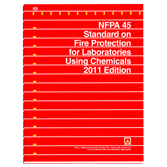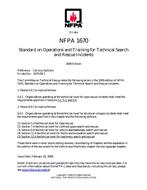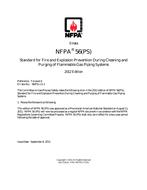Click here to purchase
Based on the latest information from the field, NFPA 400, Hazardous Materials Code is your source for specialized knowledge that helps protect workers, communities, and emergency responders.
Unsafe storage, handling, and use of hazardous materials can result in serious incidents including loss of life and millions of dollars in property damage. NFPA 400, Hazardous Materials Code provides the newest safety information for any facility or occupancy that stores, handles, or uses one or more of the covered classes of hazardous materials.
NFPA 400 consolidates requirements on oxidizers, organic peroxides, pesticides, and ammonium nitrate based on requirements from previous stand-alone documents: NFPA 430, NFPA 432, NFPA 434, and NFPA 490, respectively. It also includes requirements for materials that are classified as unstable/reactives, water reactives, corrosives, pyrophoric, toxic and highly toxic, and flammable solids.
Additional changes to Chapter 11: Ammonium Nitrate are especially important for fertilizer storage facilities.
Continuing updates made in the previous edition, Chapter 11 in the 2019 edition has been revised to facilitate a higher level of safety and compliance. Added text clarifies which sections apply retroactively, and clarifies that molten ammonium nitrate needs to be able to flow away from storage areas to open, unconfined areas free from incompatible materials. Revised fire protection system requirements specify that automatic fire sprinkler systems are not required in Type I or Type II construction buildings unless they also have combustible content. New requirements for ammonium nitrate storage in railcars address non?transportation-regulated storage.
More key changes in the 2019 edition of NFPA 400:
- Consolidated maximum allowable quantity (MAQ) tables in Chapter 5 for assembly, educational, day care, health care, ambulatory health care, detention and correctional, certain residential, and business occupancies to reduce repetition and for ease of use.
- A new table extracts common path of travel distance limits from NFPA 5000®, Building Construction and Safety Code®.
- Class II organic peroxides are divided Class IIA and Class IIB based on small-scale burn rate data and alignment with international classifications. Added definitions and updated MAQ tables include these two classes.
- New annex material shows an example of a storage layout in a typical sprinklered warehouse storing Class 1 oxidizers.
- Corresponding changes to annexes reflect revisions mentioned above.
- New annex material clarifies amounts needed to be stored within and outside of cabinets when allowed.
- Some of the assignments of organic peroxide formulation classifications in Annex F have been changed accordingly.
- For organic peroxides, changes have been made to the requirements for fire protection systems, and to remove MAQs for segregated storage and cutoff storage, because these are addressed through the protection level and control area concepts.
The 2019 edition of NFPA 400 is a critical tool for anyone responsible for the safe storage, handling, and use of hazardous materials in any occupancy, including facility owners/operators, Authorities Having Jurisdiction (AHJs), insurance professionals, and many others. (Softbound, 252 pp., 2019)
Product Details
- Published:
- 09/03/2018
- ANSI:
- ANSI Approved
- Number of Pages:
- 253


